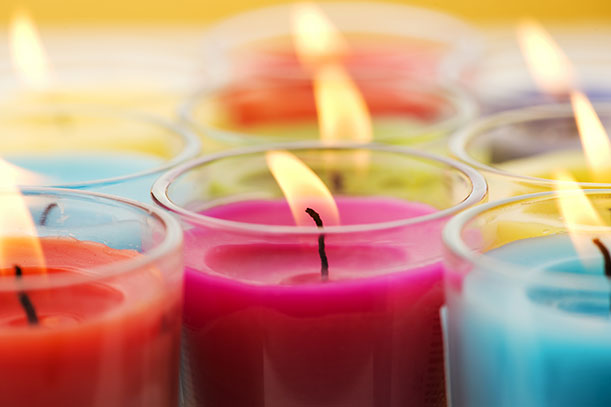BOOMbox at Home: Interacting with Fire
April 1, 2021

During spring, we're exploring the four elements of earth, air, fire, and water. This week, we’re learning more about the ways we interact with fire.
Please note--adult supervision is required for the suggested activities. We recommend taking additional safety precautions such as wearing safety glasses and heat-resistant gloves.
Heat and Light
Whether you’re sitting around a fire or touching a light bulb that is on, you probably associate light with heat. That’s because most reactions that produce light are exothermic, meaning they release heat energy. However, there are also some luminescent (light-generating) reactions that are endothermic, meaning that they absorb heat from the environment. Learn about these reactions by playing with glow sticks! Try putting one glow stick in warm water and another in cool water. Do you notice any differences in the intensity of the light? What happens if you swap them? Learn more about this experiment and the science behind the chemiluminescence of glow sticks.
Magic Tricks
If you were asked to put an egg inside a glass bottle, what would you do? Most people would probably carefully crack the egg and pour it inside. But what if you aren’t allowed to crack the egg? At first glance, it may seem impossible (unless your bottle has a very large opening)! But, with the power of fire (and science!), you can pull off this seemingly magical trick. Try an experiment to see how to push a boiled egg into a bottle using only matches.
Looking for more magic tricks? How about lighting a candle without touching it? You’ll have to start by lighting the candle normally, but once your candle has been lit, you can extinguish it and relight it from the smoke, if you act quickly. When a candle burns normally, the wax vaporizes. In the moments just after you blow out the candle, the wax vapor is still in the smoky air around the wick of the candle. When you bring a new flame in contact with the smoke, the wax vapor reignites, and the fire rapidly spreads to the candle wick. Try it for yourself!
Now that you know a fancy way of lighting a candle, how about putting it out? Fire has three key components: heat, oxygen, and fuel. The fuel is what you are burning, like a candle wick. A fire can burn out if it runs out of fuel. When you snuff out a candle by covering it, you limit the supply of oxygen. When you blow out a candle, your breath, which contains more carbon dioxide, displaces both oxygen and heat.
Fire and Food
Imagine: just after you blow out the candles on your birthday cake, you grab one and start eating it! While some candles are technically safe to eat, you probably don’t want a mouthful of wax. Luckily, with a little creativity, you can make a candle with some of the same ingredients you might include in an ice cream sundae. Get the recipe for this tasty trick.
Even if you aren’t lighting your food on fire, you may have felt like your mouth is burning after a spicy snack. Have you ever wondered why spicy food feels hot? It turns out that capsaicin, the chemical that makes food spicy, activates a few different receptors in your body that correspond to warm temperatures and pain. It’s a coincidence that this chemical happens to trigger these receptors, but because your brain expects those receptors to signal when you’re in danger of being burned, it interprets the feeling as burning, even though you aren’t in any real danger. So, while your first instinct after eating something spicy might be to reach for a glass of cold water, that might not be the best way to beat the heat. Can you find the best spice stopper?
You may have noticed that people have different levels of spice tolerance--something that tastes mild to you could be nearly unbearable for your friend or vice versa. There are a few reasons for this. One is that, just like people have different pain tolerances, some people may naturally be less sensitive to spice based on the receptors they are born with. Another factor is diet. When you eat spicy foods, you gradually desensitize your spice receptors. This builds your tolerance. People growing up in cultures where spicy food is the norm may be building up their spice tolerance without realizing it. What are some of your favorite spicy foods? Swap recipes with a friend or family member, or try looking for recipes online or in a cookbook. Maybe you’ll find a new favorite!
Artist of the Week
Moemōana Schwenke is a Samoan fire knife dancer. While modern fire dancing was revived in the 1930s, the art form has very deep roots in ancient Samoan culture. Fire knife dancing, also known as Siva Afi or Ailao Afi, grew out of traditional exhibitions where warriors would demonstrate their expertise by doing complex tricks with their weapons. Although historical accounts indicate that women may have performed in these exhibitions, today, the sport is dominated by men. Although she is only 20, Schwenke has both competed in major events as well as given guest performances for all-male competitions. She works to teach beginning dancers and support her “warrior sisters” in claiming their places on the stage.
Written by Eli.